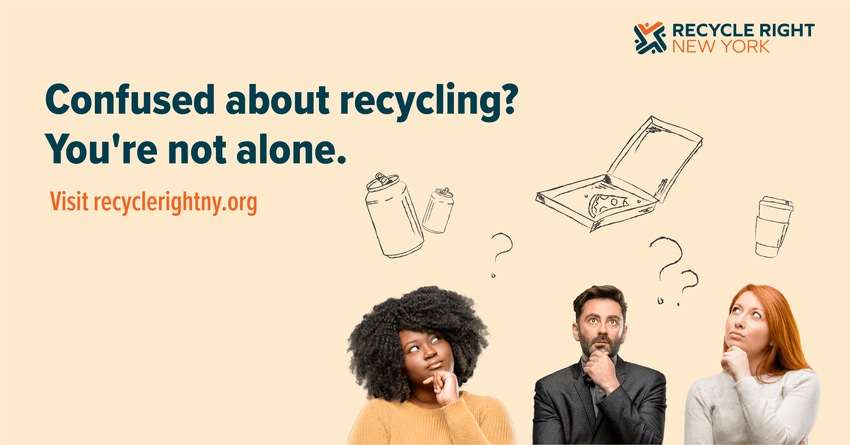Center for Sustainable Materials Management Steers New York State Toward a Circular Economy
Moving from a linear to a circular economy will require changing the way society thinks about and treats discards. The Center for Sustainable Materials Management (CSMM) is working to spur that mindset shift in New York State.

Moving from a linear to a circular economy will require changing the way society thinks about and treats discards. The Center for Sustainable Materials Management (CSMM) is working to spur that mindset shift in New York State. Administered by the state’s Department of Environmental Conservation and based at the SUNY College of Environmental Science and Forestry (ESF), CSMM collaborates with a diverse mix of stakeholders to help businesses, agencies, and communities see waste as a resource—and to guide the re-design of systems to ensure that these resources are put to their highest use.
Launched in 2020, CSMM is entrenched in a montage of projects working alongside waste pros, universities, and municipalities among partners. Some of the initiatives involve research. Some focus on community education and outreach. Others provide technical assistance to companies and organizations along their zero-waste journey. CHANEL, a stadium in Long Island, and a local furniture manufacturer are among recipients.
Kathryn Jamie Walker, executive director, Center for Sustainable Materials Management, pauses on the latter—the entities in pursuit of zero waste.
“They are at different stages along their journey, and we meet them where they are. We are collecting their waste data; understanding their systems; advising them on redesigning what they are creating; and/or looking at how they can divert downstream,” she says.
The initial goal is to help them achieve TRUE zero-waste certification, a program administered by Green Business Certification Inc. (GBCI). But the relationship will not end there.
“We will be partners for years to come to help them along this journey. It’s not like you flip a switch and it’s done. Materials management systems are complex,” Walker says.
CSSM is looking broader, aiming to capture a holistic picture of New York’s whole recycling system. The ultimate ambitions are to guide the state in developing funding programs to advance a circular economy and stronger recycling markets.
The work is beginning with a phase one needs assessment and gap analysis to provide New York State with essential data— where, how much, and what type of material is collected—to address fast-approaching policy and funding decisions.
The next phase of the assessment will evaluate the greenhouse gas and job impacts of the current recycling system. It will identify existing infrastructure (for collection, hauling, processing, recycling, and composting), as well as needed infrastructure for systems that meet the objectives outlined in the state’s 2023 solid waste management plan.
Walker sees the assessment as important to arming New York with information to be able to hit the ground running if extended producer responsibility (EPR) legislation targeting paper and packaging is signed into law. The bill, A5322A, which would hold producers responsible for managing these materials at the end of life, did not pass in the 2023 legislative session but is expected to be up for review again in 2024.
A key partner of CSMM, operating at Syracuse University, is the Center for Sustainable Community Solutions (CSCS), which delivers outreach and technical support to communities. One of its main projects is Recycle Right NY, a campaign informed by more than 140 New York State recycling professionals, focusing largely on teaching people how to deal with hard-to-recycle materials.
“Eighty-three percent of New Yorkers think recycling is important. Yet there’s not much movement [to advance this practice]. So, we help communities and our stakeholders get the right messages out,” says Melissa Young, director, Center for Sustainable Community Solutions.
University research told Young and her team that residents were not sure what to do with materials once they were through with them, and that plastic pouches and bags, batteries, and electronics were among the most confusing. So CSCS developed a statewide website for CSMM to clarify and simplify recycling and encourage reuse when that’s an option. With backing from the state's Environmental Protection Fund, the site houses videos and graphics explaining how to recycle. It features a cyclopedia enabling people to enter specific items to learn how to deal with them, and a locator tool directing them to outlets for certain materials they no longer want.
CSCS is working on strategies to engage diverse audiences in a quest to capture different demographics.
They’ve found one way is through music. Young and her team recently partnered with an organization in the Bronx to make a hip-hop video plugging Recycle Right NY and now envision a blue grass production.
“There happen to be a lot of artists on our team, so that’s where we are starting. But there are different ways to develop tailored messaging that includes local perspectives for various audiences across the state,” Young says.
CSCS also teaches college students about sustainable materials management. The students go on to develop their own outreach programs with local entities. Some of their projects have informed CSCS’s work and been a way to gain more insight into the communities it serves.
The New York State Association for Reduction, Reuse and Recycling (NYSAR3), which provides statewide leadership in sustainable materials management, has partnered with CSCS for over 10 years, and now collaborates with CSMM too. The two centers provide NYSAR3 with third-party research-based outreach and education assistance.
“This enables us to bring out issues taking well vetted, fairly neutral work done in these university settings and get it out to our members and the community. Our goals and vision are only enhanced by the work of CSMM and CSCS,” says Gary Carrel, president NYSAR3..
Partnering with higher learning institutions is proving beneficial in many ways.
“Being housed at SUNY ESF, and in-partnership with other New York state colleges and universities, allows us to directly engage with emerging professionals and students who look at evolving solutions through a different lens and stimulate innovative partnerships and creative problem solving,” Walker says.
“Through these diverse relationships, CSMM can apply our practice and research to support municipalities, the private sector, and residents seeking waste reduction and recycling solutions.”
She is optimistic that these and other collaborations will take the young nonprofit she leads further.
“It feels like in some ways we just got started, so it’s early to have a full case study showing our progress. But what shows our success right now is the partners that are already at the table … large organizations that are fully engaged and doing incredible work. The Center for Sustainable Materials Management is like a hub that is positioning itself to pull all those people into one room,” Walker says.
“We collectively challenge the concept of waste. But there is so much more to do.”
About the Author(s)
You May Also Like




